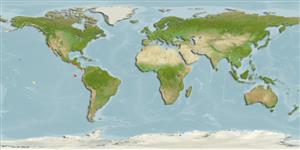Environment: milieu / climate zone / depth range / distribution range
Ecología
marino batidemersal; rango de profundidad 305 - 486 m (Ref. 31079). Deep-water
Eastern Pacific: Nicaragua and Panama; Ecuador (Galapagos Islands).
Tamaño / Peso / Age
Maturity: Lm ? range ? - ? cm
Max length : 15.2 cm SL macho / no sexado; (Ref. 31079)
Feeds on soft-bodied invertebrates and worms (Ref. 28023).
Life cycle and mating behavior
Maturities | Reproducción | Spawnings | Egg(s) | Fecundities | Larva
Richards, W.J. and J.E. McCosker, 1998. A new species of the genus Bellator (Pisces: Triglidae), with comments on the trigloids of the Galápagos Islands. Proc. Biol. Soc. Wash. 111(4):936-941. (Ref. 31079)
IUCN Red List Status (Ref. 130435)
Threat to humans
Harmless
Human uses
Herramientas
Special reports
Download XML
Fuentes de Internet
Estimates based on models
Preferred temperature (Ref.
123201): 8.9 - 11.9, mean 9.6 °C (based on 15 cells).
Phylogenetic diversity index (Ref.
82804): PD
50 = 0.5000 [Uniqueness, from 0.5 = low to 2.0 = high].
Bayesian length-weight: a=0.00617 (0.00305 - 0.01247), b=3.11 (2.94 - 3.28), in cm total length, based on LWR estimates for this Genus-body shape (Ref.
93245).
Nivel trófico (Ref.
69278): 3.3 ±0.32 se; based on food items.
Resiliencia (Ref.
120179): Medio, población duplicada en un tiempo mínimo de 1.4-4.4 años (Preliminary K or Fecundity.).
Fishing Vulnerability (Ref.
59153): Low vulnerability (10 of 100).
